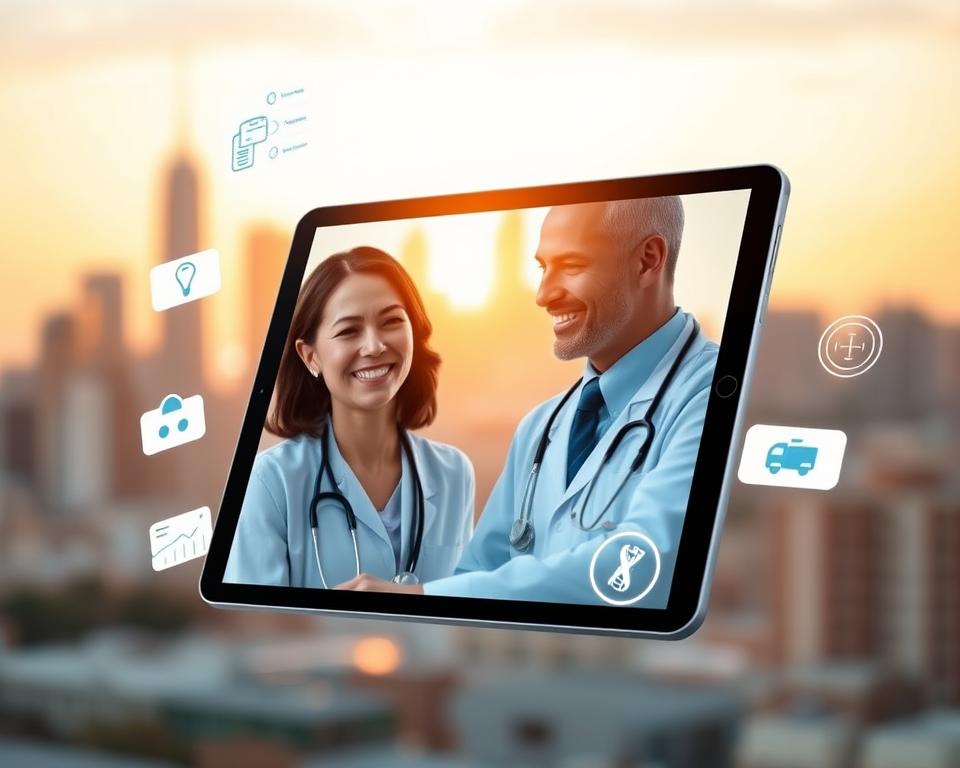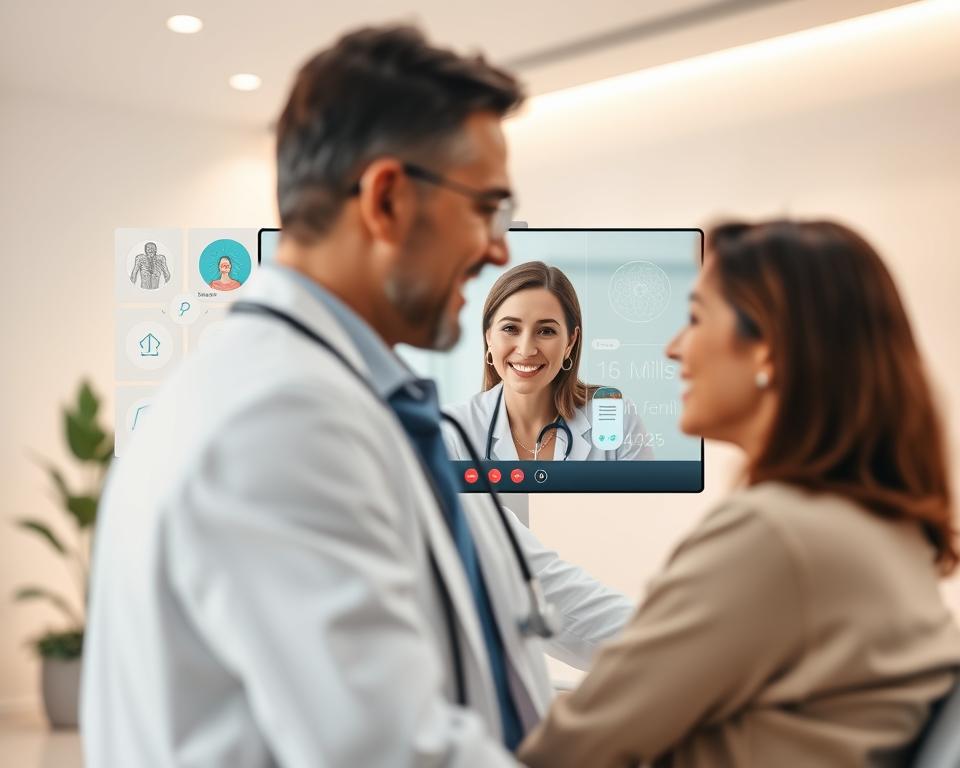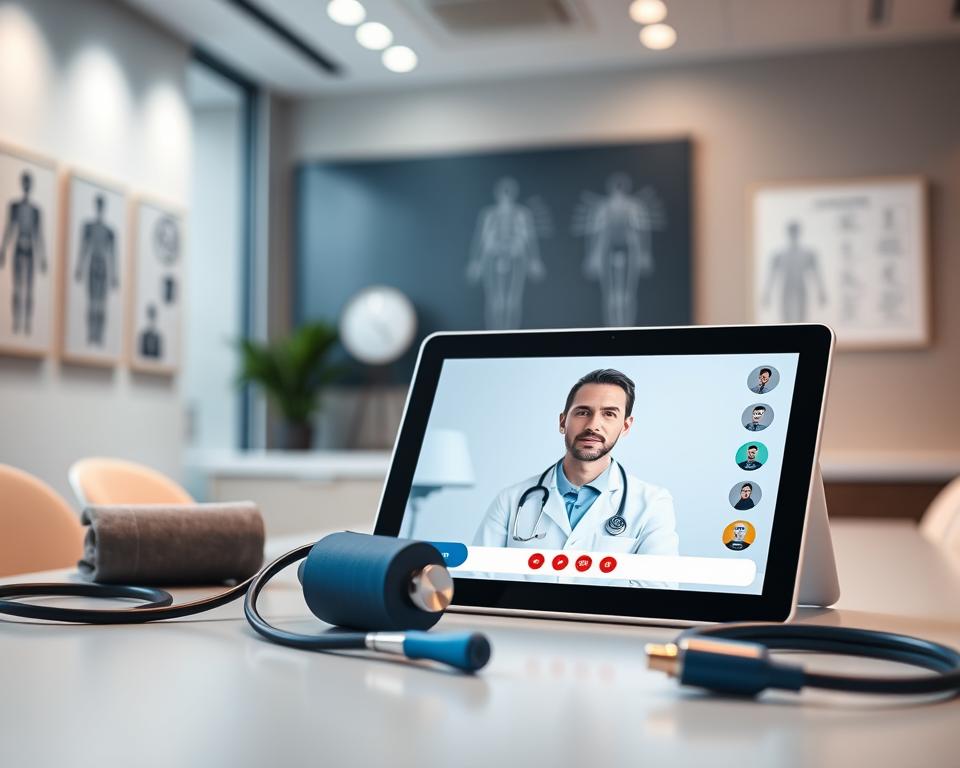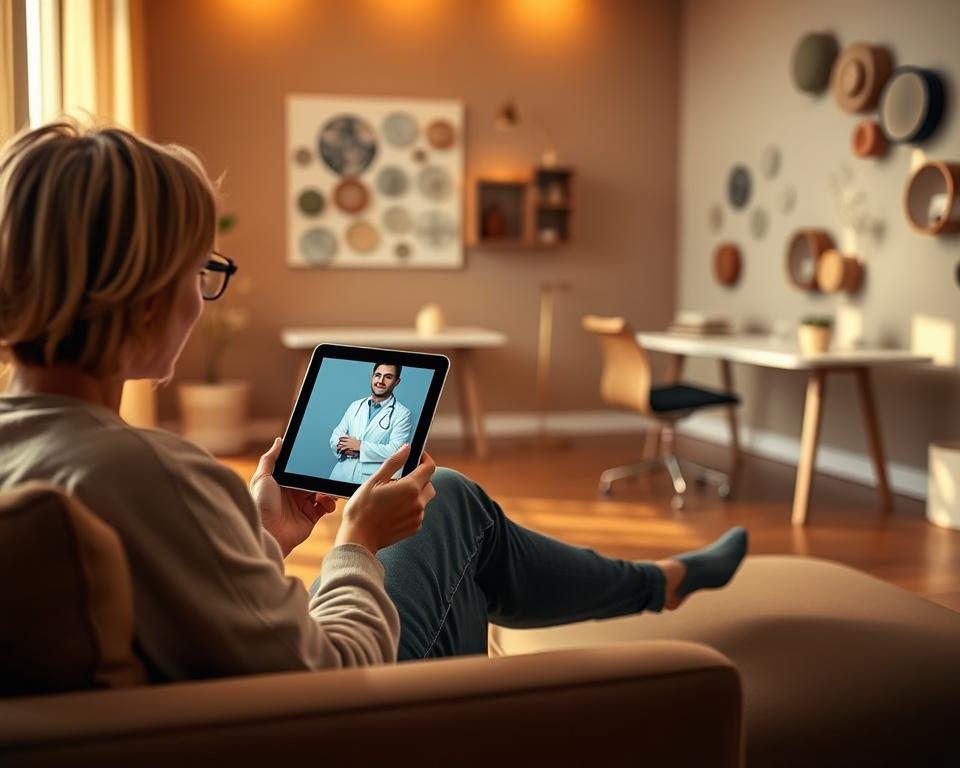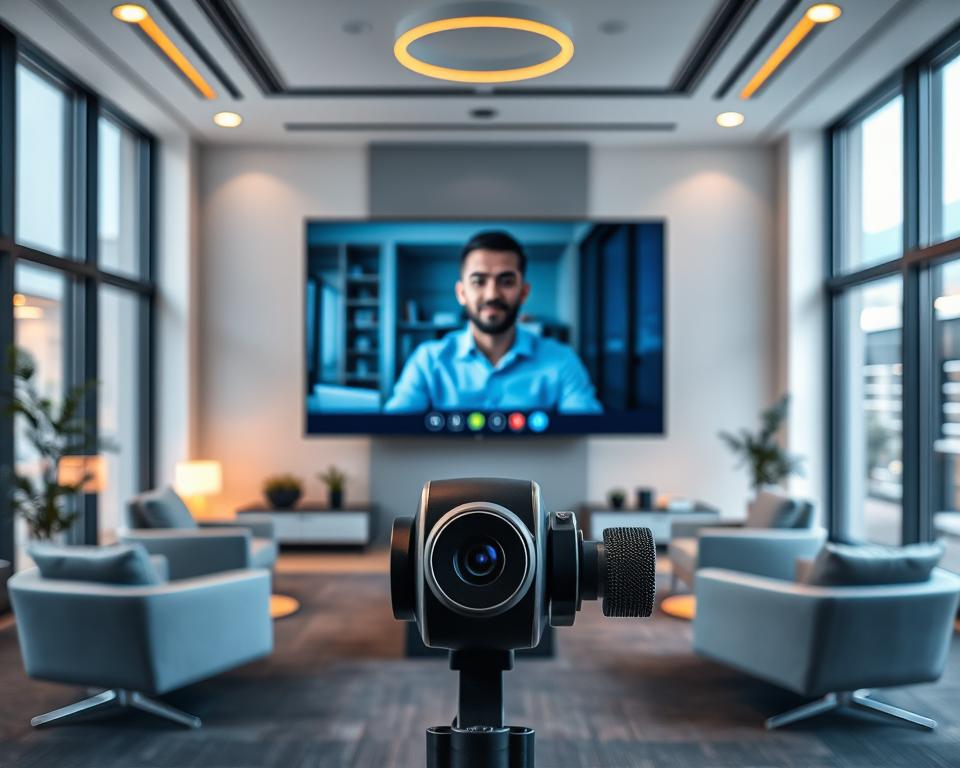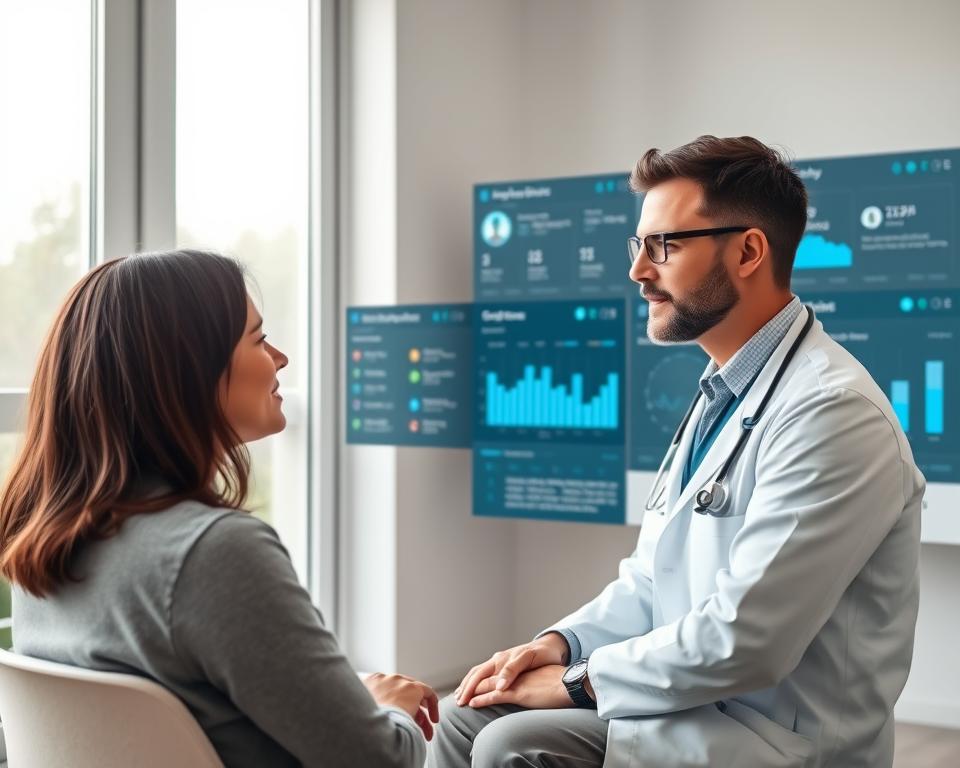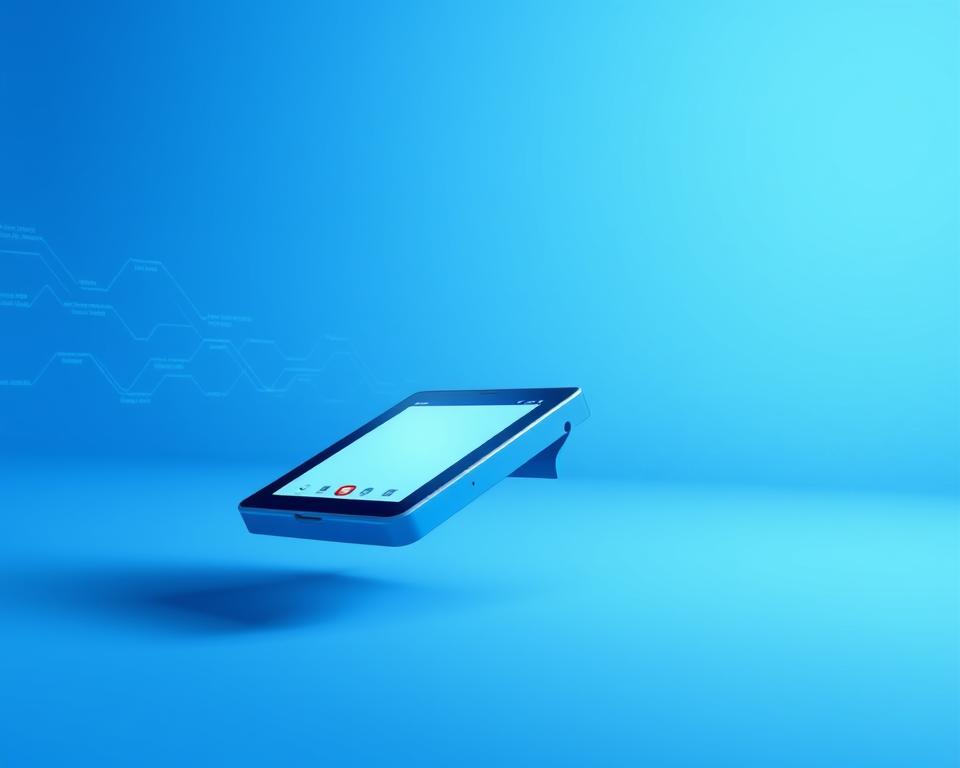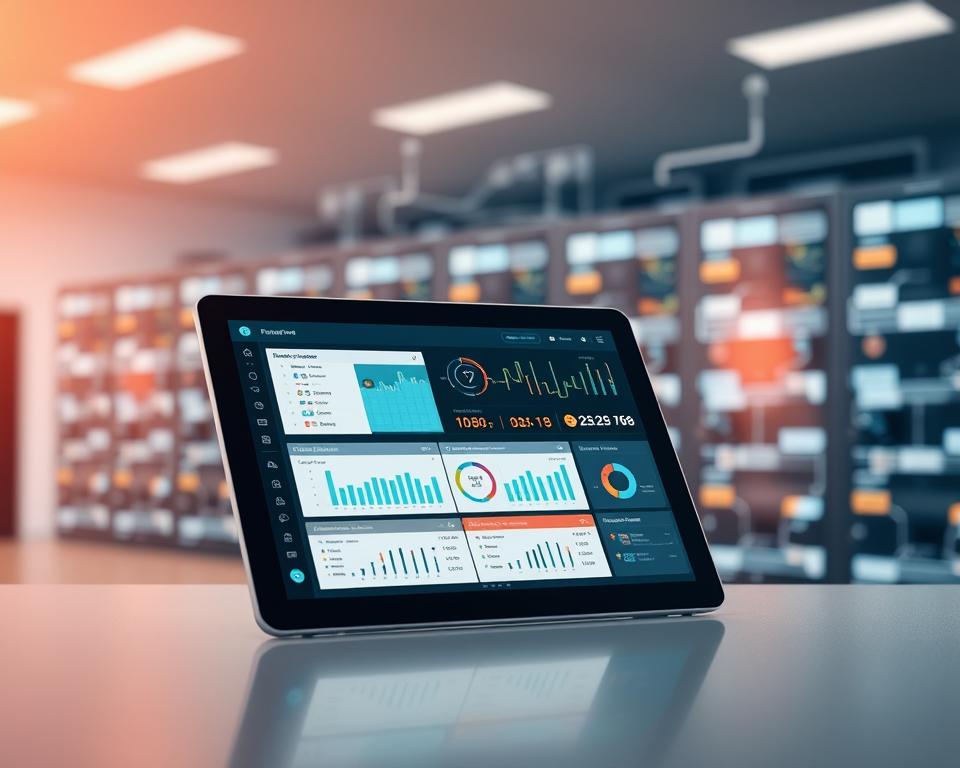Telemedicine app development is key in today’s healthcare. It lets patients easily get virtual healthcare. The need for these apps is growing fast. Reports show apps like Teladoc and Doctor on Demand have changed healthcare.
Building a telemedicine app is vital in today’s healthcare world. It offers many benefits for everyone involved. This article will guide you on how to make a successful telemedicine app. We’ll cover market demand, tech needs, and following rules.
Understanding telemedicine app development is crucial. It helps create new virtual healthcare solutions. This guide will help you build a telemedicine app. It’s perfect for starting from scratch or improving an existing app.
Table of Contents
Introduction to Telemedicine App Development
Telemedicine lets patients get healthcare at home. It involves making a platform for remote visits. This way, healthcare providers can reach more people, engage patients better, and save money.
Key Takeaways
- Telemedicine app development is a growing field with increasing demand
- Successful telemedicine platforms like Teladoc and Doctor on Demand have set the standard for virtual healthcare solutions
- Building a telemedicine app requires a deep understanding of market demand, technological requirements, and regulatory compliance
- Telemedicine app development can improve patient outcomes, enhance the healthcare experience, and reduce costs
- Entrepreneurs and healthcare professionals can create innovative virtual healthcare solutions by leveraging telemedicine app development
- Telemedicine app development involves creating a platform that enables patients to connect with healthcare providers remotely
Understanding the Telemedicine App Market
The telemedicine market has grown a lot lately. This is thanks to new healthcare technology and more people wanting remote medical care. Knowing the current state and major players in this field is key.
Reports say the global telemedicine market will hit $55.9 billion by 2025. It’s expected to grow at a 14.5% CAGR. This growth comes from more people using medical app development for easy and affordable healthcare.
Current Market Size and Growth Projections
The market is now around $24.9 billion. Big names like Teladoc and Doctor on Demand lead the way. They’ve become leaders by innovating in healthcare technology and medical app development.
Key Players Analysis: Teladoc and Doctor on Demand
Teladoc and Doctor on Demand are top in the telemedicine market. They offer services like virtual visits, prescription management, and health tracking. They make money through subscription fees, copays, and partnerships with healthcare providers.
Revenue Models and Monetization Strategies
Teladoc and Doctor on Demand make money in different ways. They include:
- Subscription fees from patients and healthcare providers
- Copays and coinsurance from insurance companies
- Partnerships with pharmaceutical companies and medical device manufacturers
- Data analytics and research services
By knowing the market size, growth, and major players, developers and investors can make smart choices. This is for medical app development and investing in healthcare technology.
Essential Features of Modern Telemedicine Applications
When it comes to healthcare software development, telehealth platforms need key features. These should focus on user experience, security, and efficiency. Some must-have features are:
- Video conferencing for remote consultations
- Secure messaging for patient-provider communication
- EHR integration for easy access to medical records
- Payment processing for convenient billing
In telehealth platforms, EHR integration is key for better patient care. By adding these features, healthcare software can make telemedicine apps more comprehensive and easy to use. The aim is to make the experience better for both patients and providers, making healthcare software development crucial for modern telemedicine.
Research shows that people like telemedicine features that are convenient and secure. By focusing on these, telehealth platforms can lead to better health outcomes and happier providers. As more people want telemedicine, the role of healthcare software development and EHR integration will grow even more.
Technical Requirements for Building a Telemedicine Platform
Creating a telemedicine platform needs a strong grasp of healthcare technology and medical app development. It’s vital to focus on HIPAA compliance to protect patient data.
Several important factors must be considered for technical requirements. These include:
- Backend infrastructure needs, like server capacity and data storage
- Frontend development aspects, including user interface and user experience design
- Database architecture and management, for secure patient data storage and retrieval
A good telemedicine platform must handle many users and data. It should also follow HIPAA compliance and keep patient information safe. By focusing on healthcare technology and medical app development, developers can make a platform that meets patient and healthcare provider needs.
Some key technical specs to think about for a telemedicine platform are:
| Specification | Description |
|---|---|
| Server Capacity | Can handle lots of users and data |
| Data Storage | Secure and follows HIPAA rules |
| User Interface | Easy and intuitive for everyone |
By carefully looking at these technical needs and focusing on HIPAA compliance, developers can make a telemedicine platform that works well and is safe. This platform will offer top-notch healthcare technology and medical app development solutions.
User Experience Design for Virtual Healthcare
In telehealth platforms, user experience is key to success. A good design can boost patient engagement, lead to better health, and more people using telemedicine. Studies show that easy-to-use and focused-on-patients interfaces make patients happier and healthier.
For telehealth platforms, user experience is essential. It helps patients move around the platform, see their health records, and talk to doctors. A great experience also keeps patients involved with their health through personalized info and reminders. This can make patients healthier and happier.
Here are some important things to think about for a good user experience in telehealth platforms:
- Simple and intuitive navigation
- Clear and concise health information
- Easy access to medical records and test results
- Secure and reliable communication with healthcare professionals
By focusing on user experience, healthcare providers can make patients more engaged, improve health, and get more people using telemedicine. As more people want telehealth, making the user experience great is key for healthcare providers to offer top-notch care.
A good user experience is critical in telehealth platforms as it can lead to higher patient satisfaction rates, better health outcomes, and increased adoption of telemedicine services.
| Telehealth Platform | User Experience Features | Patient Engagement |
|---|---|---|
| Teladoc | Intuitive navigation, clear health information | High patient satisfaction rates |
| Doctor on Demand | Easy access to medical records, secure communication | Improved health outcomes |
Security and HIPAA Compliance Requirements
Keeping patient data safe is key for telemedicine apps. They must follow strict HIPAA compliance rules. This means using strong healthcare security steps, like data encryption, to keep data safe from hackers.
To meet HIPAA compliance standards, apps must encrypt patient data. This is done in two ways: while data is moving and when it’s stored. SSL/TLS and AES are some data encryption tools used for this.
Here are some important steps for healthcare security and HIPAA compliance:
- Setting up access controls and authentication to limit who can see data
- Using HTTPS to keep data safe while it’s being sent
- Keeping software up to date to avoid security holes
By focusing on healthcare security and HIPAA compliance, telemedicine apps can protect patient data. This builds trust and confidence in healthcare services.
Video Conferencing Integration Solutions
High-quality video conferencing is key for telehealth platforms. It’s vital for virtual consultations. Many solutions are available for integrating video conferencing into telemedicine apps. These solutions focus on ease of use, compatibility, and security.
When choosing video conferencing integration, consider a few things:
- Compatibility with various devices and operating systems
- Security features, such as encryption and access controls
- Ease of use, with intuitive interfaces and minimal technical requirements
For virtual meetings to work well, video conferencing needs to offer top-notch audio and video. It should also have low latency and few disruptions. By picking a trustworthy and secure video conferencing solution, telehealth platforms can give patients the best care, no matter where they are.
As more people turn to telemedicine, the need for good video conferencing integration will grow. By focusing on this, healthcare providers can make sure patients get the care they need, whenever they need it.
Building the Patient-Doctor Matching Algorithm
Creating a good patient-doctor matching algorithm is key for telemedicine sites. It makes sure patients get the right healthcare providers for their needs. This involves a complex system that looks at many factors, like symptoms, medical history, and doctor specialties.
In the world of healthcare technology, these algorithms are crucial. They help improve care quality by using telemedicine algorithms. This makes matching patients with doctors faster and better, leading to better health outcomes. The aim is to make the experience smooth for both patients and doctors.
To make a good patient-doctor matching algorithm, we need to think about a few important things:
- Matching criteria development: We need to figure out what matters most, like symptoms, medical history, and doctor specialties.
- Algorithm implementation strategies: We must decide how to put the algorithm into action. This might involve using machine learning and natural language processing.
By making a smart patient-doctor matching algorithm, telemedicine sites can offer better care. They can also make patients happier and save money. As more people use telemedicine, the need for good algorithms will grow. This will push innovation in healthcare technology and telemedicine algorithms.
Payment Gateway Integration and Billing Systems
For telemedicine billing, a smooth payment process is key. Payment gateway integration makes healthcare payments secure and easy. In the U.S., telemedicine billing is a big part of virtual healthcare, with many payment options.
Some main ways to pay for healthcare include:
- Credit/debit card payments
- Electronic checks
- Health savings account (HSA) payments
- Insurance claims
Checking insurance coverage before visits is also important. It cuts down on claim rejections and makes payments smoother. With good payment systems and insurance checks, telemedicine offers a better experience for everyone.
A good payment system can also cut costs and improve revenue. With the right tools, telemedicine can focus on care while keeping finances stable.
By focusing on payment systems, telemedicine can improve user experience and finances. This makes payment gateway integration and telemedicine billing crucial for success.
| Payment Method | Description |
|---|---|
| Credit/Debit Card | Secure online payments using major credit/debit cards |
| Electronic Check | Online check payments for patients without credit/debit cards |
| Health Savings Account (HSA) | Payments using HSA funds for qualified medical expenses |
Electronic Health Records (EHR) Integration
Integrating Electronic Health Records (EHR) into telemedicine platforms is key in healthcare technology. It makes managing patient data easier, leading to better care and health results. As telehealth platforms become more popular, EHR integration is more vital than ever.
Some benefits of EHR integration in telemedicine include:
- Improved patient data management
- Enhanced care coordination
- Increased efficiency in clinical decision-making
But, there are challenges like interoperability and security to overcome for successful EHR integration. By using EHR integration and telehealth platforms, healthcare providers can improve care quality and patient outcomes.
The healthcare industry is always changing. The importance of healthcare technology and telehealth platforms will only grow. By focusing on EHR integration and solving its challenges, healthcare providers can lead the way in delivering top-notch, patient-focused care.
Mobile App Development Considerations
When making telemedicine apps, several important points must be considered. Mobile app development needs a good understanding of the users and their devices. For healthcare software, apps should be easy to use, secure, and work on many devices.
Key factors for mobile app development in telemedicine include:
- Creating apps for both iOS and Android
- Ensuring telemedicine apps are secure and meet standards
- Making user interfaces simple and easy to use
When developing, iOS development and Android platform specifications are crucial. This includes screen size, resolution, and operating system version. A careful and informed approach to mobile app development can lead to effective and engaging telemedicine apps.
By following best practices and staying current with healthcare software trends, developers can make a real difference. They can create telemedicine apps that help patients and healthcare providers.
| Development Platform | Key Considerations |
|---|---|
| iOS | Screen size, resolution, operating system version |
| Android | Screen size, resolution, operating system version, device fragmentation |
Testing and Quality Assurance Protocols
In telemedicine app development, testing and quality assurance are key. They make sure the app is safe, reliable, and meets quality standards. In healthcare tech, testing is vital for patient safety and well-being.
For telemedicine app development, many tests are done. These include functional, performance, and security tests. These tests find and fix bugs, making sure the app works well and is easy to use. This ensures the telemedicine app meets healthcare technology standards.
Important parts of testing and quality assurance in telemedicine app development are:
- Functional testing to ensure the app’s features work correctly
- Performance testing to evaluate the app’s speed and efficiency
- Security testing to protect patient data and prevent unauthorized access
By focusing on testing and quality assurance, developers make a trustworthy telemedicine app. This app offers top-notch healthcare technology solutions. It improves patient outcomes and experiences.
How to Build a Telemedicine App Like Teladoc or Doctor on Demand: Step-by-Step Process
The telemedicine app development process has many stages. It starts with planning and research and ends with launching the app. To make a great telemedicine app, you need a clear plan. This plan should include healthcare software development and project management.
Having a good plan for your telemedicine app development is key. It helps make sure the app works well for both patients and doctors. You need to do market research, decide on the app’s features, and set a timeline for development.
Planning and Research Phase
This first step is all about learning about your audience and what makes your app special. You also figure out what technology you need. Good project management is important here. It helps keep the app on schedule and within budget.
Development Timeline
Having a solid timeline is crucial for a timely app launch. You need to plan out resources, assign tasks, and keep track of progress. A well-organized telemedicine app development process leads to a top-notch app that users will love.
Resource Allocation
Good healthcare software development means using resources wisely. You need skilled people, like developers, designers, and project managers. Also, you need enough money and tools. With smart resource use, you can make a telemedicine app that really helps patients and improves healthcare.
| Stage | Description |
|---|---|
| Planning and Research | Gathering information, defining features and functionality |
| Development | Building the app, testing and quality assurance |
| Launch | Releasing the app, marketing and promotion |
Launch Strategy and Marketing Considerations
A successful telemedicine app launch needs a solid marketing plan. This plan should reach out to both patients and healthcare providers. Good healthcare marketing uses many channels, like social media, online ads, and partnerships with health groups.
Some key strategies for a successful launch include:
- Developing a strong online presence through a website and social media channels
- Creating engaging content, such as blog posts and videos, to promote the app and its benefits
- Utilizing digital health promotion techniques, such as search engine optimization (SEO) and pay-per-click advertising
- Building partnerships with healthcare organizations and providers to increase adoption and visibility
By using these strategies in a detailed marketing plan, a telemedicine app can effectively reach and engage its target audience. This drives adoption and growth.
| Marketing Strategy | Description |
|---|---|
| Social Media Marketing | Promoting the app through social media channels, such as Facebook and Twitter |
| Content Marketing | Creating engaging content, such as blog posts and videos, to promote the app |
| Partnerships | Building partnerships with healthcare organizations and providers to increase adoption and visibility |
By applying these marketing strategies and techniques, a telemedicine app can successfully launch and grow its user base. This improves healthcare access for both patients and providers.
Conclusion
Looking ahead, telemedicine app development will be key in the healthcare world. The pandemic has made telemedicine apps crucial for both patients and doctors.
The future of telehealth looks bright. New trends and tech are changing how we get healthcare. As more people want telemedicine, healthcare tech must keep up. This will help improve care, cut costs, and make health services better.
We must focus on making telemedicine apps safe, easy to use, and open to everyone. This way, everyone can get good care, no matter where they are or their financial situation. With more innovation, we can build a better, more patient-focused healthcare system.







